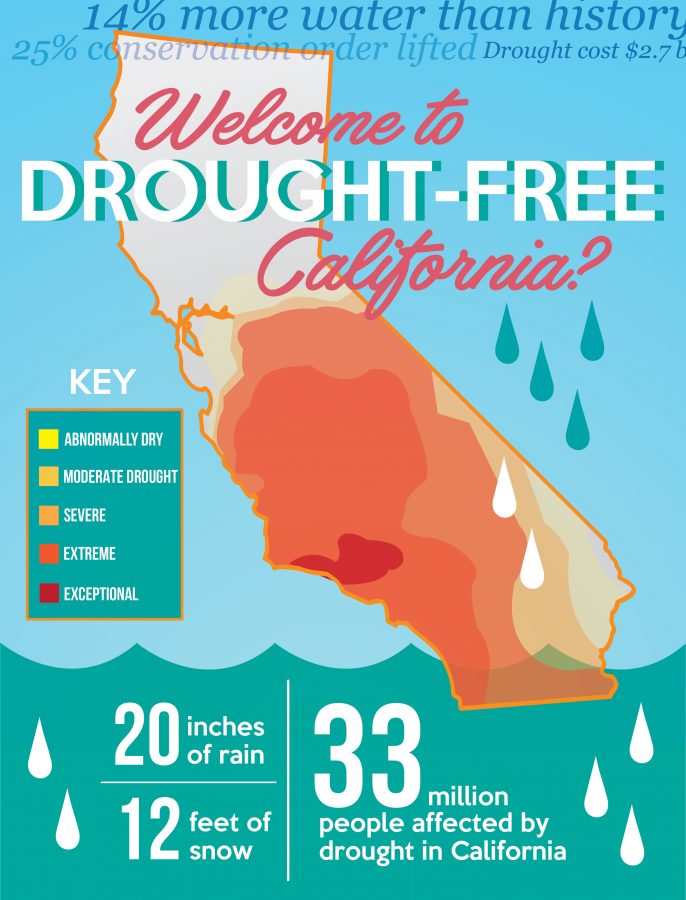Bay Area exits historic drought
While approximately 40 percent of California was in exceptional drought danger last year, only around two percent is still in that category as of Jan. 10 this year. Prolific snow this winter in the Sierra Mountain regions, as well as a recent series of rain and storms, has contributed immensely to alleviating the drought.
January 24, 2017
Due to the immense amount of rain in the past few weeks, the historic six-year drought in northern California has come to an end.
Sporadic rain in October started to improve the drought situation. Approximately 40 percent of California was in exceptional drought danger last year, according to the monitor; however, as of Jan. 10, around two percent is still in that category.
According to the U.S. Drought Monitor, all regions in northern California north of Interstate 80 are now completely free from drought. This marks the the first time that this announcement has been made since December 2011.
Gov. Jerry Brown and the state water board will be expected to talk about lifting the state of emergency for the drought originally introduced in January 2014. According to California’s Department of Water Resources, original state of emergency required a 25 percent reduction in water use statewide but was slightly alleviated last year.
Atmospheric rivers, regions in the atmosphere that transport water vapor, directed moisture to dry regions of California, causing multiple days of heavy rain and snow. Prolific snow this winter in the Sierra Mountain regions also contributed immensely to alleviating the drought.
The benefits of the rain also extended to filling lakes and reservoirs. Water levels of Lake Oroville, California’s second largest reservoir, were raised a total of 100 feet within the last month, according to the Weather Channel.
“The thing that’s most worrisome [for climate change] is fresh water. Food is also worrisome, but in theory, food shortages can be dealt with. There’s all sorts of models that show with ample land and existing technologies and so forth that we could produce a lot more food,” said Dr. John Casterline, director of the Ohio State University Institute for Population Research. “Fresh water is the real challenge because humans need water, and there’s a limited supply of it, and there are a lot of places that are already pressed to the limit in providing enough fresh water.”
Despite the positive benefits of the recent rain, it has also caused numerous floods and rockslides across California, effects that were intensified due to climate change caused by harmful human activity.
“It’s pretty clear that humans are affecting global climate,” said Lawrence Livermore National Laboratory climate researcher Benjamin Santer. “Wherever we look, we see signals of unusual change not only in these broad-brush changes in average climate but also in the intensity of droughts [and] of flooding.”
According to Business Insider, despite the recent revival of numerous lakes and reservoirs, aquifers, California’s groundwater, which accumulates below the surface of the earth in deposits, is still relatively deprived. Since the beginning of the drought, many deposits have been used up for irrigation, agriculture and industrial purposes, and only a small portion have been restored. However, with expected ongoing rain in the future, the aquifers are expected to be constantly replenished, bringing California to a state without permanent water shortages.
This piece was originally published in the pages of The Winged Post on January 24, 2017.


















![“[Building nerf blasters] became this outlet of creativity for me that hasn't been matched by anything else. The process [of] making a build complete to your desire is such a painstakingly difficult process, but I've had to learn from [the skills needed from] soldering to proper painting. There's so many different options for everything, if you think about it, it exists. The best part is [that] if it doesn't exist, you can build it yourself," Ishaan Parate said.](https://harkeraquila.com/wp-content/uploads/2022/08/DSC_8149-900x604.jpg)




![“When I came into high school, I was ready to be a follower. But DECA was a game changer for me. It helped me overcome my fear of public speaking, and it's played such a major role in who I've become today. To be able to successfully lead a chapter of 150 students, an officer team and be one of the upperclassmen I once really admired is something I'm [really] proud of,” Anvitha Tummala ('21) said.](https://harkeraquila.com/wp-content/uploads/2021/07/Screen-Shot-2021-07-25-at-9.50.05-AM-900x594.png)







![“I think getting up in the morning and having a sense of purpose [is exciting]. I think without a certain amount of drive, life is kind of obsolete and mundane, and I think having that every single day is what makes each day unique and kind of makes life exciting,” Neymika Jain (12) said.](https://harkeraquila.com/wp-content/uploads/2017/06/Screen-Shot-2017-06-03-at-4.54.16-PM.png)








![“My slogan is ‘slow feet, don’t eat, and I’m hungry.’ You need to run fast to get where you are–you aren't going to get those championships if you aren't fast,” Angel Cervantes (12) said. “I want to do well in school on my tests and in track and win championships for my team. I live by that, [and] I can do that anywhere: in the classroom or on the field.”](https://harkeraquila.com/wp-content/uploads/2018/06/DSC5146-900x601.jpg)
![“[Volleyball has] taught me how to fall correctly, and another thing it taught is that you don’t have to be the best at something to be good at it. If you just hit the ball in a smart way, then it still scores points and you’re good at it. You could be a background player and still make a much bigger impact on the team than you would think,” Anya Gert (’20) said.](https://harkeraquila.com/wp-content/uploads/2020/06/AnnaGert_JinTuan_HoHPhotoEdited-600x900.jpeg)

![“I'm not nearly there yet, but [my confidence has] definitely been getting better since I was pretty shy and timid coming into Harker my freshman year. I know that there's a lot of people that are really confident in what they do, and I really admire them. Everyone's so driven and that has really pushed me to kind of try to find my own place in high school and be more confident,” Alyssa Huang (’20) said.](https://harkeraquila.com/wp-content/uploads/2020/06/AlyssaHuang_EmilyChen_HoHPhoto-900x749.jpeg)







